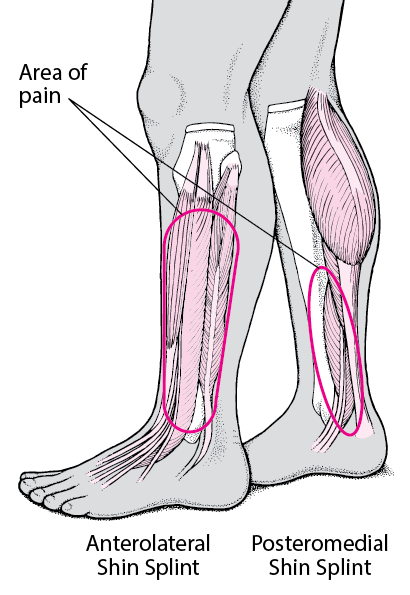Shin Splints - Fact Sheet
What Shin Splints?
Shin Splints (or Medial Tibial Stress Syndrome) generally occurs as a result of a stress reaction on the bone of the tibia (shin). This is thought to occur due to overloading of the shin area. This is generally sore with running and jumping (impact) activities and gets better with rest.
What causes it?
It is caused by a traction (pulling) stress put on the periosteum (sheath covering the shin-bone), leading to pain and inflammation of the area. This occurs from both/either the stress of impact activities through the bone itself, or by an increase in load on the calf muscles (particularly the soleus muscle). There is a significantly higher chance of developing shin splints with training with flat, unsupportive footwear on hard, unforgiving surfaces (such as road running).

Signs and Symptoms of Shin Splints ?
- Pain felt just at a particular point on the bony part of the shin, generally in the bottom third of the shin.
- Tightness of the calf and soleus muscles
- Pain worse with activity, better with rest.
.

Treatment of Anterior Shin Splints ?
Activity modification or Rest: Since shin splints is directly related to activity/impact levels, rest or activity modification is often the best solution. The pain will generally resolve over time as the bone heals, however this can take some time, even up to 12-14 weeks. If the pain is severe enough even with moderate exercise, full rest may be advised, as there is a risk of the bones developing stress fractures if you push through pain too much. Talk closely with your Physiotherapist or Exercise Physiologist to come up with a strategy to manage your exercise loads, so that your pain is manageable until it settles.
Ice, Compression, Elevation: Using ice immediately after activity may help reduce pain and inflammation. Using a compression bandage or tubigrip over the lower leg may also help. Elevating the leg after activity can also reduce inflammation after activity.
Tailored Clinical Exercise: This is important to maintain strength and function during periods of rest or activity modification. If you rest completely to reduce pain, then go straight back into full activity or competition, the risk or re-irritation or injury is quite high. Maintaining strength and mobility is key to preventing this.



